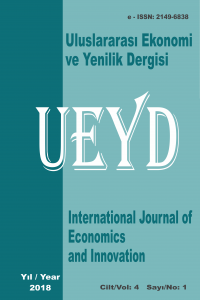Öz
Bu makale Markov zincir
modelini kullanarak kaba boşanma oranlarını tahmin etmektedir. Markov modelleri
27 Avrupa Birliği ülkesinin boşanma oranları için oluşturulmuştur. Boşanma
oranları, başlangıç olasılık matrisi ve geçiş olasılığı matrisinin çarpımı ile
tahmin edilir. Tahminlerin limit matrisleri bulunmuştur. Bu çalışmanın temel
sonuçları şunlardır: i) 2015 yılı itibarıyla üst kategoride gerçekleşen boşanma
oranlarının uzun vadede aynı kategoride kalması. ii) Sadece Belçika’nın kaba
boşanma hızı, mutlaka AB 2015 ortalamasının üzerinde gerçekleşecek ve durağan
kalacaktır. iii) Üç ve dört kategoriye sahip Markov modellerine dayanılarak,
2018 boşanma oranları büyük olasılıkla daha düşük kategorilerde gerçekleşecek
ve durağan hale gelecektir, iv) Türkiye'nin ham kaba boşanma hızı uzun vadede kesinlikle
AB 27'nin 2015 ortalamasının altında kalacaktır ve v) Beş kategori ile
oluşturulan Markov modellerine göre başlangıç boşanma olasılığı üst
kategorilerde olan ülkelerin boşanma hızının üst kategorilerde ve başlangıç
olasılığı alt kategorilerde olan ülkelerin boşanma hızının ise alt
kategorilerde durağanlaşacaktır.
Anahtar Kelimeler
Kaynakça
- Balestrino, A., Ciardi, C., ve Mammini, C., (2013), “On the Causes and Consequences of Divorce”, The Journal of Socieconomics, 45, 1-9.
- Crosby, J., F., (1980), “A Critique of Divorce Statistics and Their Interpretation”, Family Relations, 29(1), 51-58.
- Eurostat (2017), http://ec.europa.eu/eurostat/statistics-explained/index.php/File:Crude_divorce_rate,_selected_years,_1960-2015_(per_1_000_persons).png
- González-Val, R., ve Marcén M., (2012), “Breaks in the Breaks: An Analysis of Divorce Rates in Europe”, International Review of Law and Economics, 32(2), 242-255.
- González, L. ve Viitanen, T., K., (2009), “The Effect of Divorce Laws on Divorce Rates in Europe”, European Economic Review, 53(2), 127-138.
- Hiller, V., ve Recoules, M., (2013), “Changes in Divorce Patterns: Culture and the Law”, International Review of Law and Economics, 34, 77-87.
- Kıral, E., ve Mavruk, C., (2017), “Tax Declaration Rates Via Audits: A Prediction Using Markov Model”, Journal of Business Economics and Finance, 6(2), 97-111.
- Kneip, T., ve Bauer, G., (2009), “Did Unilateral Divorce Laws Raise Divorce Rates in Western Europe?”, Journal of Marriage and Family, 71(3), 592-607.
- Meagher, J., (2015), “Why does Ireland have the lowest divorce rate in the EU?” https://www.independent.ie/life/family/family-features/why-does-ireland-have-the-lowest-divorce-rate-in-the-eu-34217513.html
- Smith, S., Maas, I., ve Tubergen, F., (2012), “Irrencilable Differences? Ethnic Intermarriage and divorce in the Netherlands, 1995-2008”, Social Science Research, 41, 1126-1137.
- Wagner, M., ve Weiβ, B., (2006), “On The Variation of Divorce Risks in Europe: Findings From a Meta-Analysis of European Longitudinal Studies", European Sociological Review, 22(5), 483-500.
Öz
This article estimates crude divorce rates using
Markov chain model. Markov models are constructed for the divorce rates of 27
European Union countries. Divorce rates are estimated by the product of the
initial probability matrix and transition probability matrix. Limiting matrices
of the estimations are found. Main results of this study are i) divorce rates
in higher categories in 2015 stay in the same categories in the long run, ii)
Only Belgium’s crude divorce rate will certainly be realized and be stationary
over 2015 mean of EU 27, iii) Based on Markov models with three and four
categories, 2018 divorce rates will more likely be realized and be stationary
in lower categories, iv) Turkey’s crude divorce rate will certainly be under
2015 mean of EU 27 in the long run, and v) Based on Markov model with five
categories, the divorce rate of the countries with
higher likelihood of divorce in the upper categories will be stationary in the
upper categories and the divorce rate of the countries with lower likelihood of
starting in the lower categories will be stationary in the lower categories.
Anahtar Kelimeler
Kaynakça
- Balestrino, A., Ciardi, C., ve Mammini, C., (2013), “On the Causes and Consequences of Divorce”, The Journal of Socieconomics, 45, 1-9.
- Crosby, J., F., (1980), “A Critique of Divorce Statistics and Their Interpretation”, Family Relations, 29(1), 51-58.
- Eurostat (2017), http://ec.europa.eu/eurostat/statistics-explained/index.php/File:Crude_divorce_rate,_selected_years,_1960-2015_(per_1_000_persons).png
- González-Val, R., ve Marcén M., (2012), “Breaks in the Breaks: An Analysis of Divorce Rates in Europe”, International Review of Law and Economics, 32(2), 242-255.
- González, L. ve Viitanen, T., K., (2009), “The Effect of Divorce Laws on Divorce Rates in Europe”, European Economic Review, 53(2), 127-138.
- Hiller, V., ve Recoules, M., (2013), “Changes in Divorce Patterns: Culture and the Law”, International Review of Law and Economics, 34, 77-87.
- Kıral, E., ve Mavruk, C., (2017), “Tax Declaration Rates Via Audits: A Prediction Using Markov Model”, Journal of Business Economics and Finance, 6(2), 97-111.
- Kneip, T., ve Bauer, G., (2009), “Did Unilateral Divorce Laws Raise Divorce Rates in Western Europe?”, Journal of Marriage and Family, 71(3), 592-607.
- Meagher, J., (2015), “Why does Ireland have the lowest divorce rate in the EU?” https://www.independent.ie/life/family/family-features/why-does-ireland-have-the-lowest-divorce-rate-in-the-eu-34217513.html
- Smith, S., Maas, I., ve Tubergen, F., (2012), “Irrencilable Differences? Ethnic Intermarriage and divorce in the Netherlands, 1995-2008”, Social Science Research, 41, 1126-1137.
- Wagner, M., ve Weiβ, B., (2006), “On The Variation of Divorce Risks in Europe: Findings From a Meta-Analysis of European Longitudinal Studies", European Sociological Review, 22(5), 483-500.
Ayrıntılar
| Birincil Dil | Türkçe |
|---|---|
| Bölüm | Araştırma Makaleleri |
| Yazarlar | |
| Yayımlanma Tarihi | 20 Nisan 2018 |
| Gönderilme Tarihi | 23 Şubat 2018 |
| Yayımlandığı Sayı | Yıl 2018 Cilt: 4 Sayı: 1 |
Cited By
Analysis and prediction of annual precipitation values in Cyprus
Desalination and Water Treatment
https://doi.org/10.5004/dwt.2020.25088
Film Analizi Yöntemi ile Farklı Kültürlere Bakış: Boşanma ve Çocuk
Gazi Üniversitesi Gazi Eğitim Fakültesi Dergisi
https://doi.org/10.17152/gefad.1360821
MARKOV ZİNCİRLERİ KULLANILARAK SEÇMEN TERCİHLERİNİN TAHMİN EDİLMESİ
Çukurova Üniversitesi Sosyal Bilimler Enstitüsü Dergisi
Selim GÜNDÜZ
https://doi.org/10.35379/cusosbil.671862
Uluslararası Ekonomi ve Yenilik Dergisi
Karadeniz Teknik Üniversitesi, İİBF, İktisat Bölümü, 61080, Trabzon/Türkiye
https://dergipark.org.tr/en/pub/ueyd
This work is licensed under a Creative Commons Attribution 4.0 International License.


